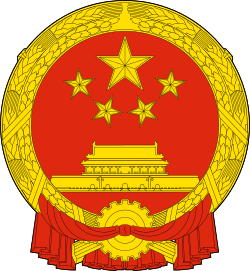People's democratic dictatorship
 |
| This article is part of a series on the politics and government of China |
|
|
| Part of a series on |
| Maoism |
|---|
 |
|
"People's democratic dictatorship" (simplified Chinese: 人民民主专政; traditional Chinese: 人民民主專政; pinyin: Rénmín Mínzhǔ Zhuānzhèng) is a phrase incorporated into the Constitution of the People's Republic of China by Mao Zedong, leader the Communist Party of China (CPC).[1] The concept, and form of government, is similar to that of people's democracy, which was implemented in Eastern Europe under the guidance of the Soviet Union.
The premise of the "People's democratic dictatorship" is that the CPC and state represent and act on behalf of the people, but possess and may use dictatorial powers against reactionary forces.[2] Implicit in the concept of the people's democratic dictatorship is the notion that dictatorial means are a necessary counterforce to recidivist social elements, and that without such a dictatorship, the government may collapse into a dictatorship of the bourgeoisie or other degenerate social form, faulting on the socialist state charter which is its first principle.
Origins
The term's best known usage occurred on June 30, 1949, in commemoration of the 28th Anniversary of the founding of the Communist Party of China. In his speech, On the People's Democratic Dictatorship, Mao expounded his ideas about a People's Democratic Dictatorship as well as provided some rebuttals to criticism that he anticipated he would face.[3]
See also
References
- ↑ "CONSTITUTION OF THE PEOPLE'S REPUBLIC OF CHINA". People's Daily Online. Retrieved 2009-11-23.
The People's Republic of China is a socialist state under the people's democratic dictatorship led by the working class and based on the alliance of workers and peasants.
- ↑ Meisner, Maurice, Mao's China and After 3rd Edition, (New York: The Free Press, 1999), pp.58-60.
- ↑ MacFarquhar, Roderick; Fairbank, John King (1991). Cambridge History of China: The People's Republic, Part 2 : Revolutions Within the Chinese Revolution, 1966-1982. Cambridge University Press. p. 6.